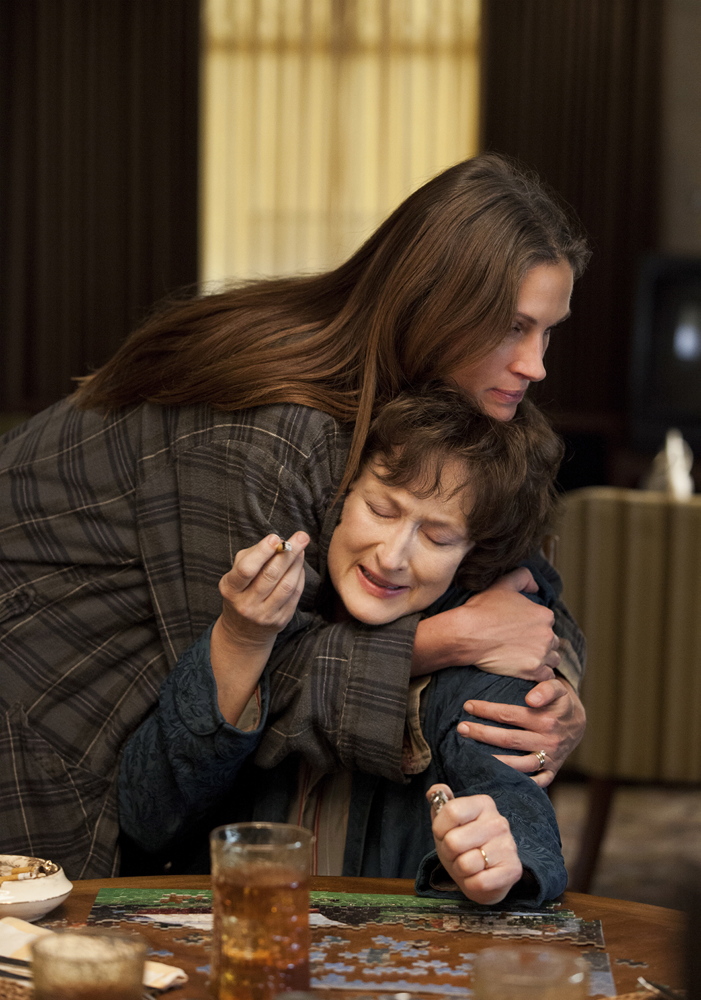Do you need closure?
Then the following story may disappoint.
It will leave you with few answers, only questions. It will frustrate you, entice you with its potential, and then, just when you think you’re seeing an act of resolution, it will simply, and abruptly, stop. I apologize. But it seems fitting.
It is about audience reactions to the endings of three movies: “All Is Lost,” which finds Robert Redford alone on a sinking boat (now playing); the Coen brothers’ “Inside Llewyn Davis,” about the early ‘60s folk scene in Greenwich Village (opening Dec. 20); and “August: Osage County,” the Meryl Streep-Julia Roberts drama culled from the Pulitzer-winning Tracy Letts play (opening Christmas Day).
Because this story is about endings, it would seem polite to post a requisite SPOILER ALERT, but the truth is that I will not give away the endings of these films, because I could not tell you what happens anyway.
Neither can the filmmakers.
Neither can the audiences.
By design.
After much shouting, scheming and cataclysm, each of these films (though arguably less so with “Osage County”) simply ends. The resolutions, abrupt and ambiguous. The conclusions, decidedly inconclusive.
“What!?!” shouted the burly guy behind me as the end credits of “All Is Lost” suddenly kicked in.
“Huh?” asked the young woman seated in front of me as “Llewyn Davis” cryptically faded to black.
And “What the hell does that mean?” whispered the elderly man beside me as “Osage County” concluded.
I shrugged and thought: I’m not meant to know.
You’ve heard of the “cold opening,” the blunt, flourish-free opening pioneered by “Saturday Night Live”? This is the flip side: the cold ending, the unexpected, unannounced exit. Being an art-house convention (even cliche) for at least as long as there have been art-house theaters, it’s not exactly a revolutionary technique. But with audiences – and even many art-house audiences – the cold ending remains radical. Even infuriating. That guy behind me during “All Is Lost” sat quietly through the film, seemingly absorbed. The audience itself felt perched forward, edge of its seats, anxious as the water rose around Redford and his options fell. And then, at the moment when the film appeared to settle Redford’s fate, director J.C. Chandor faded the screen to black – or rather, to white, the brightness of the movie screen illuminating the theater.
No winding-down, no speech – none of the comforting familiar beats we expect from an ending.
Nothing but white.
Dude behind me? Lost it, loudly: “That’s it? Really? Really? Worst movie ever! Oscar contender!?”
He wasn’t alone: I heard several variations on that theme as I left the theater, all from moviegoers who were so enraged by this sharp, jarring conclusion that they were literally throwing Bobby out with the bathwater.
LOOSE ENDS LEFT UNTIED
Similarly, at the end of “Llewyn Davis,” once the story of the yearning title character (played by newcomer Oscar Isaac) is brought full circle, and a few loose ends are tied up (though you are keenly aware of just how many remain unresolved), the Coens fade to black. When I saw it, a puzzled silence settled over the theater. And this was closing night of the Chicago International Film Festival – with Isaac in attendance.
The heart hates what it hates.
And all too often our collective moviegoing heart cannot abide not knowing how a story turns out, from cradle to grave. That festival audience, while not as outwardly incensed as the “All Is Lost” audience, could not bring itself to even politely clap. But it gives away nothing to say that Llewyn, who arrives in the folk scene just before Dylan, is positioned as a cult star, an almost success – his story, as ramshackle as his ambitions, is not about careerism but a personal, increasing self-awareness, if not necessarily growth.
The narrative machinery of a movie tends to dictate its options, and the tidier the bow you place on a movie as merrily unsettled as “Llewyn Davis,” the more you arrive at a slight, insincere movie about a predictable musician. Likewise, if “Captain Phillips” faded to black the moment after the stand-off between Tom Hanks and the Somali pirates was decided, it would have been abrupt; we knew too much about Phillips not to need a glimpse of the aftermath. But “All Is Lost” is about a man in a storm on a sinking boat, and we know nothing about Redford’s character – not even his name. The film is pared to two elements: life and death.
What else do you need to know about?
Of course, there are times when non-ending endings are cop-outs – pretentious devices trotted out by filmmakers who have painted themselves into corners – and not thoughtful, unavoidable decisions. But the cold endings of “All Is Lost” and “Llewyn Davis” are the only endings that could be arrived at – they are not so much brave choices as necessary ones. That said, what maybe frustrates the audiences for these movies is that there is no real degree of finality offered – you probably want to know what Bill Murray said to Scarlett Johansson at the end of “Lost in Translation,” but the ambiguity of that ending didn’t solicit loud of cries of protest in theaters because Sofia Coppola gave their relationship a clearish, if melancholy finish.
Likewise, though a lot has been written recently about the flood of survival movies about people who find themselves in increasingly worsening, alienating conditions – “Captain Phillips,” “12 Years a Slave, “Gravity,” “All Is Lost” – there is a reassurance at work in most. As much as these movies seem to spring out of some collective societal uncertainty, only “All Is Lost” leaves the audience with real precariousness.
Of that group, only “All Is Lost” is the genuine hard sell.
COENS HAVE LEFT US HERE BEFORE
But it’s not like we haven’t had decades to prep: The Coens themselves royally outraged audiences by ending their Oscar-winning thriller “No Country for Old Men” (2007) – like the Cormac McCarthy novel it was adapted from – with a speech from a sheriff who, so disgusted by the cruelty he’s witnessed, simply washes his hands of the situation. Their next film, “A Simple Man” (2009), about a set-upon professor whose life is unraveling, ended even more abruptly: Our hero opens a door and finds himself staring at an impending tornado. I’ve seen that movie once and this final, alarming image is as seared into me as a childhood dream.
Besides, classics as varied as “Easy Rider,” “Monty Python and the Holy Grail,” “Picnic at Hanging Rock,” “Children of Men” and “L’Avventura” – and films as recent as “Take Shelter,” “The Grey” and “Martha Marcy Mary Marlene” – end just as sharply. The visceral gasp of being left hanging feels intrinsic to their impact. And of course, it’s not as if film has a lock on sudden non-summarizing summaries: Kafka never did explain what Josef K was accused of, and mostly famously of all, we never will know what happen to Tony Soprano after creator David Chase cut from that Sopranos family meal and mysterious lurker to a black TV screen.
Would you really be satisfied if you knew?
Many years ago, I saw Prince in concert; he was a pure magic for three hours. Then, poof, gone, no encore. The people around me were confused and outraged; I was startled myself by the breach of concert decorum.
But in the brief blackout between the show itself and the lights coming up – in that short inserted darkness – a euphoric final image was locked in my brain. Just as perpetual anxiety was locked in by “The Sopranos” and wistfulness was held in place by the fade to black of “Llewyn Davis.” What more do we want?
The movie version of “August: Osage County” presents a horrible alternative.
The outcome is no less etched in stone than the endings offered by “Llewyn Davis” and “All Is Lost.” Like the play, the story is somewhat about the unknowability of family; on stage, it ends with the matriarch, drunk and cancer-ridden, crawling on a staircase, howling for someone, anyone. She has driven most everyone off.
Cut to black.
The film – again, no spoilers – also offers this image of despair and unsettled business. Except, perhaps because harsh outlooks are indeed harsh, we get an addendum, where a famous actress stares into the middle distance, radiating self-empowerment. It’s the easy, clear landing the work does not want, the and-then-what-happens reassurance only the most literal-minded moviegoer would demand. Having pushed the characters into an abyss, the film offers a ladder to climb out at the last minute. We’re still not certain if they climb, but we have a firm idea, a pat on the shoulder that settles the butterflies. It also locks an entirely specific emotion in your head, and by the time the house lights have come up, you’ve already forgotten the film.
Copy the Story LinkSend questions/comments to the editors.





Success. Please wait for the page to reload. If the page does not reload within 5 seconds, please refresh the page.
Enter your email and password to access comments.
Hi, to comment on stories you must . This profile is in addition to your subscription and website login.
Already have a commenting profile? .
Invalid username/password.
Please check your email to confirm and complete your registration.
Only subscribers are eligible to post comments. Please subscribe or login first for digital access. Here’s why.
Use the form below to reset your password. When you've submitted your account email, we will send an email with a reset code.